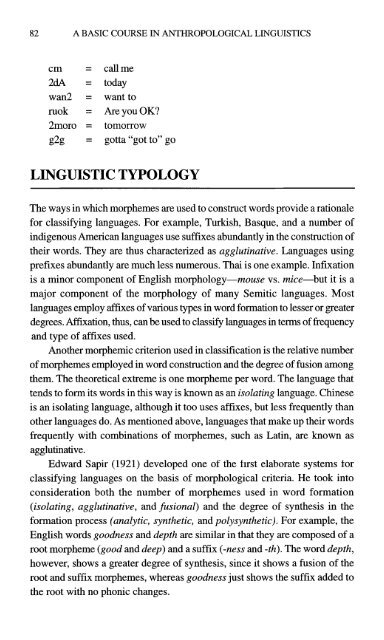A Basic Course in Anthropological Linguistics (Studies in Linguistic ...
A Basic Course in Anthropological Linguistics (Studies in Linguistic ...
A Basic Course in Anthropological Linguistics (Studies in Linguistic ...
You also want an ePaper? Increase the reach of your titles
YUMPU automatically turns print PDFs into web optimized ePapers that Google loves.
82 A BASIC COURSE IN ANTHROPOLOGICAL LINGUISTICS<br />
cm = callme<br />
2dA = today<br />
wan2 = want to<br />
ruok = AreyouOK?<br />
2moro = tomorrow<br />
g2g = gotta “got to” go<br />
LINGUISTIC TYPOLOGY<br />
The ways <strong>in</strong> which morphemes are used to construct words provide a rationale<br />
for classify<strong>in</strong>g languages. For example, Turlush, Basque, and a number of<br />
<strong>in</strong>digenous American languages use suffixes abundantly <strong>in</strong> the construction of<br />
their words. They are thus characterized as agglut<strong>in</strong>ative. Languages us<strong>in</strong>g<br />
prefixes abundantly are much less numerous. Thai is one example. Infixation<br />
is a m<strong>in</strong>or component of English morphology-mouse vs. mice-but it is a<br />
major component of the morphology of many Semitic languages. Most<br />
languages employ affixes of various types <strong>in</strong> word formation to lesser or greater<br />
degrees. Mixation, thus, can be used to class@ languages <strong>in</strong> terms of fiequency<br />
and type of affixes used.<br />
Another morphemic criterion used <strong>in</strong> classification is the relative number<br />
of morphemes employed <strong>in</strong> word construction and the degree of fusion among<br />
them. The theoretical extreme is one morpheme per word. The language that<br />
tends to form its words <strong>in</strong> this way is known as an isolat<strong>in</strong>g language. Ch<strong>in</strong>ese<br />
is an isolat<strong>in</strong>g language, although it too uses affixes, but less frequently than<br />
other languages do. As mentioned above, languages that make up their words<br />
frequently with comb<strong>in</strong>ations of morphemes, such as Lat<strong>in</strong>, are known as<br />
agglut<strong>in</strong>ative.<br />
Edward Sapir (1921) developed one of the flrst elaborate systems for<br />
classify<strong>in</strong>g languages on the basis of morphological criteria. He took <strong>in</strong>to<br />
consideration both the number of morphemes used <strong>in</strong> word formation<br />
(isolat<strong>in</strong>g, agglut<strong>in</strong>ative, and fusional) and the degree of synthesis <strong>in</strong> the<br />
formation process (analytic, synthetic, and polysynthetic). For example, the<br />
English words goodness and depth are similar <strong>in</strong> that they are composed of a<br />
root morpheme (good and deep) and a suffix (-ness and -th). The word depth,<br />
however, shows a greater degree of synthesis, s<strong>in</strong>ce it shows a fusion of the<br />
root and suffix morphemes, whereas goodness just shows the suffix added to<br />
the root with no phonic changes.






